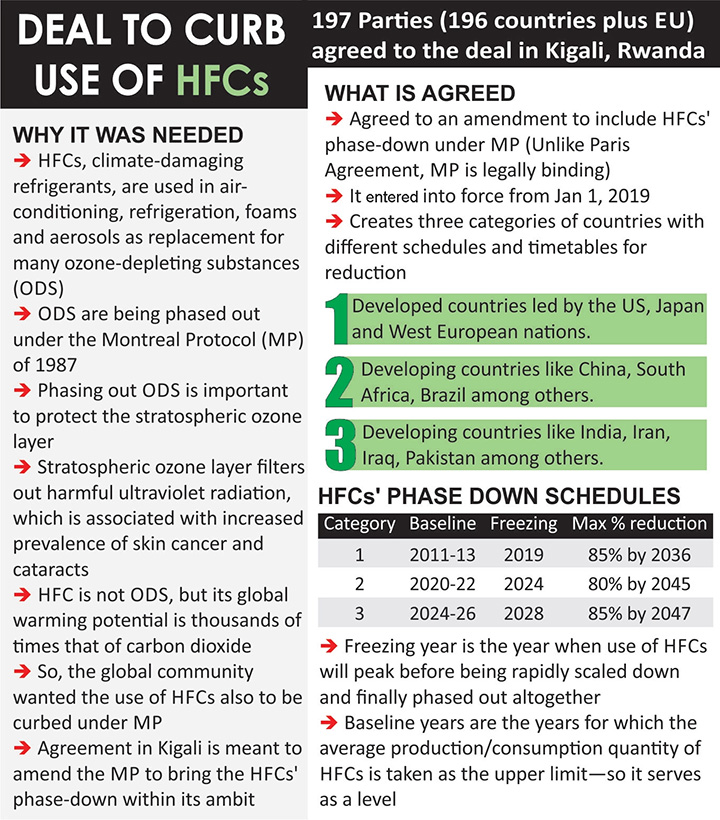India Decides to Ratify the Kigali Amendment | 20 Aug 2021
Why in News
Recently, the Union Government approved the ratification of the Kigali Amendment to the Montreal Protocol on phasing down climate-damaging refrigerant Hydrofluorocarbons (HFCs).
- It comes close on the heels of similar decisions by the United States and China, the world’s largest producers and consumers of HFCs. 122 countries had ratified the Kigali Amendment by the end of July 2021.
Key Points
- About:
- The United States, China and India are in separate groups of countries, with different time schedules to phase out their HFCs and replace them with climate-friendly alternatives.
- India has to reduce its HFC use by 80% by the year 2047, while China and the United States have to achieve the same target by the year 2045 and 2034 respectively.
- India will complete its phasedown of HFCs in four steps from 2032 onwards with a cumulative reduction of 10% in 2032, 20% in 2037, 30% in 2042 and 80% in 2047.
- Amendments to the existing legislation framework, the Ozone Depleting Substances (Regulation and Control) Rules to allow appropriate control of the production and consumption of hydrofluorocarbons to ensure compliance with the Kigali Amendment will be done by mid-2024.
- Background:
- The 1989 Montreal Protocol is not a climate agreement. It is instead aimed at protecting the earth from Ozone-Depleting Substances (ODSs) like the ChloroFluoroCarbons (CFCs), that were earlier used in the air-conditioning and refrigerant industry.
- The widespread use of CFCs had caused a hole in the Ozone layer of the atmosphere, which allowed some harmful radiation to reach the earth. These radiations were considered potential health hazards.
- The Montreal Protocol led to the replacement of CFCs with Hydrofluorocarbons (HFCs) which do not destroy the Ozone layer.
- But they were later found to be extremely potent in causing Global Warming. So, the HFCs solved one problem, but were contributing in a major way to another.
- But these could not be eliminated under the original provisions of Montreal Protocol which was meant to phase-out ODSs only.
- The Kigali Amendment enabled the Montreal Protocol to mandate the elimination of HFCs as well.
- In October 2016, with the United States’ leadership, 197 countries adopted an amendment to phase down HFCs under the Montreal Protocol in Kigali, Rwanda.
- The 1989 Montreal Protocol is not a climate agreement. It is instead aimed at protecting the earth from Ozone-Depleting Substances (ODSs) like the ChloroFluoroCarbons (CFCs), that were earlier used in the air-conditioning and refrigerant industry.
- Kigali Amendment to Montreal Protocol:
- The Kigali Amendment aims for the phase-down of hydrofluorocarbons (HFCs) by cutting their production and consumption.
- The goal is to achieve over 80% reduction in HFC consumption by 2047.
- Given their zero impact on the depletion of the ozone layer, HFCs are currently used as replacements of hydrochlorofluorocarbons (HCFCs) and chlorofluorocarbons (CFCs) in air conditioning, refrigeration and foam insulation, however they are powerful greenhouse gases.
- Under the amendment :
- Developed countries will reduce HFC consumption beginning in 2019.
- Most developing countries will freeze consumption in 2024,
- Some developing countries including India with unique circumstances will freeze consumption in 2028.
- The plan also provides financing to certain countries, to help them transition to climate-friendly alternatives.
- With the Kigali Amendment, the Montreal Protocol has become an even more powerful instrument against global warming.
- Significance:
- This important instrument is crucial to achieving the target of restraining the increase in global temperatures to 2 degree Celsius from pre-industrial times.
- As pointed out by a recent report of the Intergovernmental Panel on Climate Change (IPCC), the average temperature of the planet has already risen by about 1.1 degree Celsius.
- The collective action is expected to prevent emissions of upto 105 million tonnes of carbon dioxide equivalent of greenhouse gases helping to avoid up to 0.5 degree Celsius of global temperature rise by 2100, while continuing to protect the ozone layer.
- Because HFCs were not ozone-depleting, they were not controlled substances under the Montreal Protocol. They were part of the problematic greenhouse gases whose emissions are sought to be curtailed through climate change instruments such as the Kyoto Protocol of 1997 and the 2015 Paris Agreement.
- But the Montreal Protocol has been a far more effective and successful agreement than the climate change instruments. It has already resulted in the phase-out of 98.6% of ozone-depleting substances. The remaining 1.4% are the HCFCs that are in the process of being transitioned.
- This important instrument is crucial to achieving the target of restraining the increase in global temperatures to 2 degree Celsius from pre-industrial times.
- Significance for India:
- India became a party to the Montreal Protocol on Substances that Deplete the Ozone Layer in June 1992 and since then has ratified the amendments to the Montreal Protocol. India has successfully met the phase-out targets of all the Ozone Depleting Substances as per the Montreal Protocol Schedule.
- India is one of the first countries in the world to launch a cooling action plan in 2019. This comprehensive plan is aimed at reducing cooling demand, enabling refrigerant transition, enhancing energy efficiency and better technology options with a 20-year time horizon.
- The signing of the Kigali Amendment is a cue for the markets to make a faster transition from HFCs to cleaner gases.
- It would boost domestic manufacturing and employment generation goals.
- The ratification would signify that India is ready to compete in the market for low-Global Warming Potential GWP (climate-friendly) refrigerants, which will spur domestic innovation and attract international investments.
- The decision would pave the way for India to achieve its climate change mitigation goals and cooling commitments. India is among a small group of countries on track to meet its climate commitments under the Paris Agreement.

